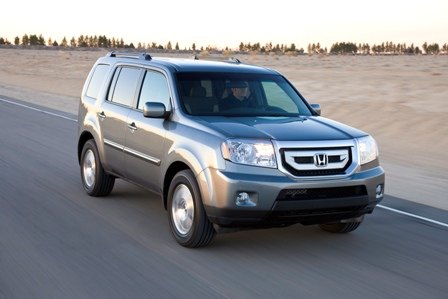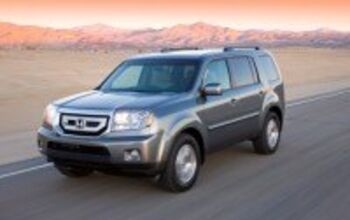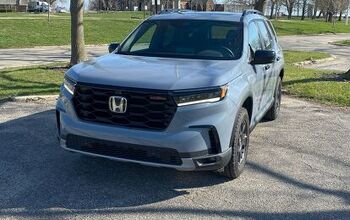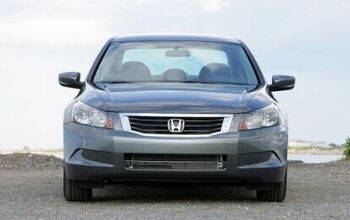2009 Honda Pilot Review
Honda was the first automaker to offer Americans a car-based SUV with a third row of seats. It didn’t matter that an Odyssey minivan was more fun to drive. Families wanted a third row without the stigma of a minivan or the bulk of a conventional SUV. The Pilot outsold all other midsize car-based SUVs. Then new competitors piled into the segment: Hyundai Veracruz, GMC Acadia, Mazda CX-9 and more. Honda lost its place at the head of the class. For the 2009 model year, Honda has responded with a fully redesigned Pilot. Have they done enough to reclaim their supremacy?
The original Pilot was a blandly inoffensive box on wheels. The new Pilot sports a bulkier nose, a higher beltline, more Hummeresque side windows (let us not speak ill of the dead) and a chrome butt strip. The formerly cute ute looks much more like a conventional SUV– except for the clunky grille. (Honda designer Dave Marek says the new design will grow on you; so can fungus.)
The same, more massive aesthetic has been applied to the Pilot’s interior. The center stack, the center console, and the door panels all have the chunky forms typical of a conventional full-size SUV.
If this were a Chrysler, we’d be saying that the interior plastics look cheap. Since it’s a Honda, we’ll say they look “affordable.” As in cheap. Surfaces display the sheen you’d expect from budget grade rock-hard polymers, while the instrument panel includes far too many prominently located cut lines. Want something nicer? Honda invites you to pick up an MDX. Alternatively, you could buy a competitor’s product.
Like a conventional SUV, the Pilot’s windshield is downright upright. The instrument panel isn’t minivanishly deep and visibility is excellent. Although the Pilot’s front seats are larger and cushier than those found in smaller Hondas, there’s less lateral support than Hillary Clinton affords Barak Obama. Also on the downside, the Pilot’s shifter has moved to the left side of the center stack. It’s an improvement over the old column shifter, but the cog swapper’s positioning isn’t ideal for anyone who likes to drive.
The new Pilot has all the width of a full-size SUV. In terms of length and wheelbase, both dimensions have increased by about three inches; remaining about ten inches shorter than competitors. Legroom in the second row is up an inch, third row limb accommodation is up nearly two inches. The second row adjusts a few inches fore-and-aft, but adults will want it all the way back.
Humans up to six feet tall can now fit into the Pilot’s third row, with little room to spare. The wayback seats are positioned above the first two rows, providing occupants with a pleasantly unobstructed view forward. But the chairs are still too close to the floor to provide adults with enough thigh support to prevent Restless Leg Syndrome.
The Pilot’s relatively short exterior length also compromises cargo volume. The Honda can carry eight people or their luggage, but not both at the same time. As with the third row, you’ll find more room elsewhere.
Honda’s secured an extra six horses for the Pilot’s 3.5-liter V6, for a total of 250. The i-VTEC system makes the most of what’s there, stumping-up 253 ft. lbs. of torque. Unfortunately, there’s no noticeable difference in performance. Why would there be? The Pilot’s curb weight has increased to 4500 lbs. (with all wheel-drive). To compensate for the heft’s effect on gas consumption, the powerplant now runs on three or four cylinders while cruising. The resulting 16/22 EPA numbers are competitive, but hardly qualify as a unique selling point.
The Pilot’s automatic five-speed gearbox remains. (Most competitors have a sixth ratio, which enables a shorter first gear for stronger acceleration off the line.) The Pilot’s steering feels a bit firmer than before. Thanks to improved suspension tuning, the Pilot no longer leans like a boat through the turns. But the not-so-cute-ute is about as much of a sporting machine as the [only slightly less expensive] Panasonic EP3005 massage chair.
Disappointingly, the Pilot’s new underpinnings don’t deliver markedly improved ride quality or a vast reduction in noise levels. If you’re looking for a bargain-basment alternative to premium-branded products, this ain’t it.
The new Pilot doesn’t change the game the way the original did. There’s not a single area in which it excels, in a field crowded with excellent products. Of course, the same could be said of the old Pilot, of which Honda sold quite a few. Much like the previous model, the new Pilot is a vehicle for those who will only consider a Toyota or Honda, and want something roomier than the Highlander. Honda bunted. The Pilot’s a base hit.
Michael Karesh lives in West Bloomfield, Michigan, with his wife and three children. In 2003 he received a Ph.D. from the University of Chicago. While in Chicago he worked at the National Opinion Research Center, a leader in the field of survey research. For his doctoral thesis, he spent a year-and-a-half inside an automaker studying how and how well it understood consumers when developing new products. While pursuing the degree he taught consumer behavior and product development at Oakland University. Since 1999, he has contributed auto reviews to Epinions, where he is currently one of two people in charge of the autos section. Since earning the degree he has continued to care for his children (school, gymnastics, tae-kwan-do...) and write reviews for Epinions and, more recently, The Truth About Cars while developing TrueDelta, a vehicle reliability and price comparison site.
More by Michael Karesh
Latest Car Reviews
Read moreLatest Product Reviews
Read moreRecent Comments
- ToolGuy 9 miles a day for 20 years. You didn't drive it, why should I? 😉
- Brian Uchida Laguna Seca, corkscrew, (drying track off in rental car prior to Superbike test session), at speed - turn 9 big Willow Springs racing a motorcycle,- at greater speed (but riding shotgun) - The Carrousel at Sears Point in a 1981 PA9 Osella 2 litre FIA racer with Eddie Lawson at the wheel! (apologies for not being brief!)
- Mister It wasn't helped any by the horrible fuel economy for what it was... something like 22mpg city, iirc.
- Lorenzo I shop for all-season tires that have good wet and dry pavement grip and use them year-round. Nothing works on black ice, and I stopped driving in snow long ago - I'll wait until the streets and highways are plowed, when all-seasons are good enough. After all, I don't live in Canada or deep in the snow zone.
- FormerFF I’m in Atlanta. The summers go on in April and come off in October. I have a Cayman that stays on summer tires year round and gets driven on winter days when the temperature gets above 45 F and it’s dry, which is usually at least once a week.







































Comments
Join the conversation
I've owned my 09 Pilot Touring for about two months now. While I agree with some of the points made in this article, I've found it to be a very good vehicle thus far. We researched and test drove for many months before deciding on the Pilot. One thing you have to remember when comparing here...its a mid-sized SUV, not comparable with an Armada or a Tahoe in heft, but much bigger than a CR-V, Escape or Forester (which is really a wagon if you ask me). Anyhow, my wife really found the people hauling the most important and the Pilot can haul 8 (3 small folks across the back) and the Highlander, CX-9 and MDX cannot...period. The rear seat is unlivable in the Highlander and MDX, so-so in the CX-9, but still not as big as the Pilot. The Pilot is not a minivan, so don't compare it to the Odyssey (our last vehicle) for interior room. No comparison, the Ody wins, as would any minivan. The fuel consumption and less-than-impressive acceleration in the Pilot are my biggest complaints. Fuel consumption is rated the same as the other mid-sized SUVs, but I think the CX-9 and Highlander had better acceleration. Braking is something that supposedly the Pilot also falls behind in. I haven't noticed yet, but the fact that the Pilot rides on 17 inch wheels, while the Highlander Limited is on 19s and the CX-9 Touring sits on 20s means something to me! I guess that means smaller brake rotors for me also, but I have a smoother ride and will not die of shock when I have to replace those tires (so I'll just try not to tailgate). I just came back from a trip to the mountains with my Pilot. We used it to pull my bro-in-law's 23 foot pontoon boat out of the water and towed it 10 miles back to his cabin. Total weight of boat and trailer was around 3500lbs. While not the best towing vehicle because of its short wheelbase (it feels tentative in front of that trailer), it had no problems pulling that boat. We found its short wheel base a great manuevering advantage when it came time to backing that boat and trailer into its tight parking spot amongst the trees at the cabin. Much easier than using his F-150. But, again, if you do a lot of towing of big boats or campers, I'm not sure this is the vehicle, but its okay for the occasional weekender or vacation. All in all, its a good vehicle for the price and its a Honda, so I know it will do well for us over the next 10 years. Fit and finish are about the same as our Odyssey, which is to say, its above average but not superb (as the author eluded to, they save that for the Acura line).
I went to the Honda dealership to look at this vehicle. I was disappointed with this vehicle. No one should say anything about Chrysler products having a cheap looking dash. Pilot's interior is awash in cheap-looking hard-plastic trim," writes Consumer Guide. I agree its plastic dash is not in style with a vehicle that cost this much. The leather seats are too hard and not that comfortable. The vehicle is heavy and you can tell it on acceleration. Talking to people that own this vehicle they said it is not good on gas but I guess if you can pay for this vehicle you can afford the gas. I liked the Hemi Commander and Chevy Traverse much better with the Traverse way on top of the Commander or Pilot. With Honda having average or better-than-average predicted reliability that may be a factor in the purchase of this vehicle if you are willing to give up some comfort and other factors.